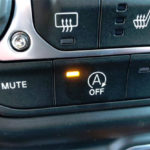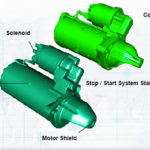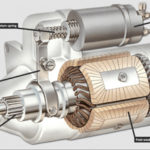The stop/start approach has significant implications for the car’s battery and battery management system (BMS).
Q: How does the battery charge/discharge cycle function in a non-stop/start vehicle?
A: In a car without a stop/start system, starting the engine is a one-time event for the duration of the trip. While the engine is running, it also turns an alternator (an AC generator), charging the battery via an AC-DC rectifier. The battery is continuously recharged while the engine is running and supplies power for all the needed electrical functions, including the ignition system and spark plugs, nearly countless microcontroller and small motors (seats, windows), to the infotainment and advanced driver-assistance systems (ADAS), so there is no net discharge from the battery. The system is designed so the alternator charges the battery to match the load and can even charge it at a higher rate than the load drain to “top off” the battery.
Q: What’s different in a stop/start vehicle?
A: Obviously, the battery encounters a series of start and stop periods. Even where the car is stopped d, and the engine shut down, such as at a traffic light, the car’s other electrically-powered critical functions such as lights, windshield wipers, radio, or displays still need power, and the less-critical systems such as infotainment do as well. This is a challenge for the battery as it must deliver power while it is not being recharged.
Q: What’s the resulting impact?
Clearly, adequate battery recharging during rides with many stops/starts may not happen (Figure 1). Aggravating the situation, especially with old batteries and in winter, the battery’s ability to accept charge is reduced. This can result in the gradual discharge of the battery so that at some point, the battery no longer has enough energy to re-start the engine.

Q: What are the general characteristics of a “conventional” car battery?
A: Most of today’s cars today use gel batteries, which improve the earlier “wet” batteries. The latter must occasionally be “topped off” with distilled (mineral-free) water, while the former is a “closed” battery where any hydrogen which is generated (and represents water loss) by the battery is recombined so that topping up is not required.
In both types, the positive and negative electrodes are surrounded by an electrolyte. Still, in the gel implementation, the electrolyte is not in liquid form but rather is in the form of a gel due to the addition of silica. This provides greater resistance to vibration of the vehicle, resistance against problems on inclines (think off-road vehicles) and eases handling and improves safety; if the battery is an intact state after an accident or case crack (it happens), the user does not need to be concerned with leaking fluid. Gel batteries are often referred to as maintenance-free batteries.
Q: Is there a problem using wet or gel batteries with stop/start?
A: Gel batteries have low electrode wear, resulting in longer service life compared to conventional lead-acid batteries. However, due to their increased internal resistance, the gel batteries cannot produce high cold-start currents within short intervals, which is needed for stop/start. A second disadvantage is their susceptibility to temperature fluctuations and performance fall-off in colder weather.
Q: What’s the solution to this dilemma?
A: There are two approaches: one is to use an additional battery, preferably at a higher nominal voltage as it would offer more reserve capacity; it would also have reduced IR-drop losses due to lower currents for the same amount of delivered power. This is one of the many reasons driving the inclusion of 48-V (nominal) batteries in addition to a 12-V battery, with the BMS handling the charging and discharging of both, as well as charge-sharing between them in both directions.
Q: What’s the alternative battery technology?
A: It’s called the absorbent glass mat (AGHM) battery. In an AGM battery, the electrolyte is completely bound in a glass fiber mat. As with gel batteries, AGM batteries are leak-proof and can also deal with inclined positions without problems. In comparison with conventional starter batteries, AGM batteries can withstand three times as many charging cycles. AGM batteries are specifically designed for vehicles with automatic start-stop systems and increased power demands.
Q: What are some of the key characteristics of AGM batteries with respect to stop/start?
A: Due to their technology, the internal resistance of AGM batteries remains considerably lower than that of conventional batteries and does so over their entire life. This internal resistance is an important factor in delivering adequate starter voltage, as the currents are on the order of 100 to 200 A, and even a few volts of IR-induced drop from a 12-V source is a serious loss.
Also, the higher and constant cold-start current further makes the AGM battery the better choice for vehicles with stop/start technology (and HEVs with their regenerative braking for recovery of braking energy). Their ability to support a large number of charging cycles increases the service life and, therefore, cost-effectiveness. Conventional gel and wet batteries are designed for use as supply batteries but are limited in performance when used as starter batteries and do not perform well with cars having automatic start-stop systems,
Q: What are the other important attributes of AGM batteries?
- They offer a balanced state of charge: in hybrid vehicles, the battery is charged by a braking energy-recovery system as well as the alternator (generator). In contrast, wet or gel starter batteries must be kept fully charged for optimum performance and are poor at accepting any energy generated by regenerative braking. AGM batteries, however, can operate in the partial-charge range and therefore provide sufficient “extra” capacity to store the energy which is generated by braking.
High reserve capacity: The cycle stability of AGM technology ensures there will be power available to supply other vehicle functions while also providing a high starting power. Even if the battery is not fully charged because other car functions are enabled during a stop cycle, the battery has the reserve power to restart the car.
Q: Is AGM the only alternative?
No, there are others. For example, VARTA (now also known as Clarios) offers enhanced flooded batteries (EFB), which have what they maintain is superior reliability and performance compared to standard lead-acid batteries for automotive and commercial vehicle applications. EFB batteries support applications that operate at a partial state of charge and do not require an AGM battery’s deep-cycling characteristics. This technology is well-suited for a high number of engine starts and extended engine-off periods, and improved charge acceptance compared to conventional batteries. Compared to AGM technology, Varta claims it is a better fit for start-stop vehicle technologies without regenerative braking technology (non-HEVs).
The next part of this article looks at mechanical wear issues due to the stop/start operation.
Related EE World Content
Are power systems up to the task of running self-driving cars?
Power modules lessen the load on internal combustion engines
Today in Engineering History: Internal Combustion Engine Patented
Hybrid EVs come to touring car racing
How bidirectional converters speed the design of dual-battery automotive systems
External References
There’s a lot of information available about stop/start, as there is almost anything related to cars: it’s a big industry that affects just about everyone in one way or another. Perhaps because stop/start is relatively new, contrary to tradition, and has many technical and driver-related issues, the content of these sites ranges from personal opinion to technical discussion to in-depth technical analysis. These are the useful sites and sources I reviewed for this article:
- Green Car Reports, “Don’t start-stop systems wear out your car’s starter?”
- Autocar, “Stop-start systems: is there a long-term impact on my car’s engine?”
- CarPro USA, “Understanding Stop/start Systems”
- Driving, “How It Works: Starters and automatic start-stop technology”
- Varta (Clarios), “Reasons why the start-stop system does not work”
- Varta (Clarios), “What is automatic start-stop and how does it work?”
- Varta (Clarios), “Why do I need a special battery for the automatic start-stop system?”
- Varta (Clarios), “Start-Stop”
- The Jag Wrangler, “SmartStartStop”
- The Truth About Cars, “The Problem With Start-Stop Systems”
- Best Ride, “Does Auto-Stop/Start Technology Wear Out Engine Components?”
- Practical Motoring, “Myth-busting: Does stop-start damage your engine?”
- NAPA, “Stop-Start Technology — Pros and Cons”
- Idle Smart, “Pros and Cons of Automatic Engine Stop/start Solutions”
- How Stuff Works, “Love It or Hate It: Stop-start Technology Is Here to Stay”
- Wikipedia, “Start-stop system”
- STMicroelectronics, “48V Start-Stop System”
- Daimler, “Under the microscope: ECO stop/start: Sophisticated technology gives the highest levels of efficiency”
- Argonne National Laboratory, “Start and Restart Effects on Modern Vehicle Starting Components”
- Bosch, “Full power for stop/start”
- How a Car Works, “How the starting system works”
- Your Mechanic, “How Does a Starter Motor Work?”
- General Motors, “Cadillac’s Electric Self Starter Turns 100”
- Elreg Distributors, “The Evolution of the Starter Motor”
- PR Newswire, “ZMJ and CRCI to Acquire Bosch’s Starters and Generators Business”
- TechLink, “Enhanced Starter Motor Operation in Engine Stop/Start Systems”
- JeepFan, “How Electronic Start Stop ESS Works on the Jeep Wrangler JL”
- Autoblog/Verizon Media, “Mazda introduces clever start-stop system with direct injection”







Leave a Reply